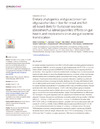Please use this identifier to cite or link to this item:
https://accedacris.ulpgc.es/jspui/handle/10553/57434
| Title: | Dietary phytogenics and galactomannan oligosaccharides in low fish meal and fish oil-based diets for European sea bass (Dicentrarchus labrax) juveniles: Effects on gut health and implications on in vivo gut bacterial translocation | Authors: | Torrecillas Burriel,Silvia Terova, Genciana Makol, Alex Serradell, Antonio Valdenegro, Victoria Gini, Elisabetha Izquierdo, Marisol Acosta, Félix Montero, Daniel |
UNESCO Clasification: | 310502 Piscicultura | Issue Date: | 2019 | Project: | Dieta Funcional Para Sustitución de Ingredientes Marinos en Peces: Maximización de Resistencia A Patogenos Via Refuerzo de Barreras Epiteliales y Herramientas de Inmunización | Journal: | PLoS ONE | Abstract: | European sea bass were fed four low FM/FO (10%/6%) diets containing galactomannan oligosaccharides (GMOS), a mixture of garlic oil and labiatae plants oils (PHYTO), or a combination of both functional products (GMOSPHYTO) for 63 days before exposing the fish to an intestinal Vibrio anguillarum infection combined with crowding stress. In order to evaluate functional diets efficacy in terms of gut health maintenance, structural, cellular, and immune intestinal status were evaluated by optical and electron microscopy and gene expression analyses. A semi-automated software was adapted to determine variations in goblet cell area and mucosal mucus coverage during the challenge test. Feeding with functional diets did not affect growth performance; however, PHYTO and GMOS dietary inclusion reduced European sea bass susceptibility to V. anguillarum after 7 days of challenge testing. Rectum (post-ileorectal valve) showed longer (p = 0.001) folds than posterior gut (pre-ileorectal valve), whereas posterior gut had thicker submucosa (p = 0.001) and higher mucus coverage as a result of an increased cell density than rectum. Functional diets did not affect mucosal fold length or the grade of granulocytes and lymphocytes infiltration in either intestinal segment. However, the posterior gut fold area covered by goblet cells was smaller in fish fed GMOS (F = 14.53; p = 0.001) and PHYTO (F = 5.52; p = 0.019) than for the other diets. PHYTO (F = 3.95; p = 0.049) reduced posterior gut goblet cell size and increased rodlet cell density (F = 3.604; p = 0.068). Dietary GMOS reduced submucosal thickness (F = 51.31; p = 0.001) and increased rodlet cell density (F = 3.604; p = 0.068) in rectum. Structural TEM analyses revealed a normal intestinal morphological pattern, but the use of GMOS increased rectum microvilli length, whereas the use of PHYTO increased (p≤0.10) Ocln, N-Cad and Cad-17 posterior gut gene expression. After bacterial intestinal inoculation, posterior gut of fish fed PHYTO responded in a more controlled and belated way in terms of goblet cell size and mucus coverage in comparison to other treatments. For rectum, the pattern of response was similar for all dietary treatments, however fish fed GMOS maintained goblet cell size along the challenge test. | URI: | https://accedacris.ulpgc.es/handle/10553/57434 | ISSN: | 1932-6203 | DOI: | 10.1371/journal.pone.0222063 | Source: | PLoS ONE [ISSN 1932-6203], v. 14 (e0222063) |
| Appears in Collections: | Artículos |
Items in accedaCRIS are protected by copyright, with all rights reserved, unless otherwise indicated.
